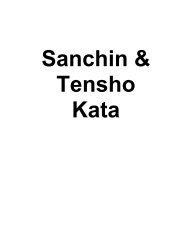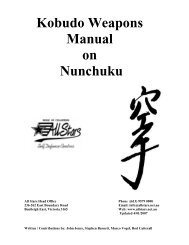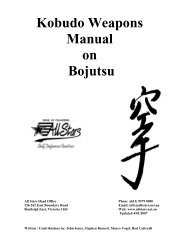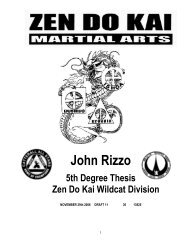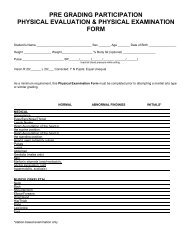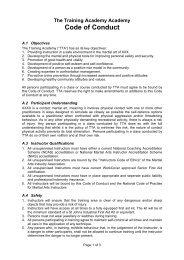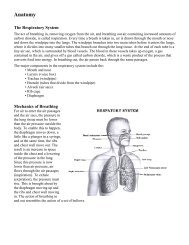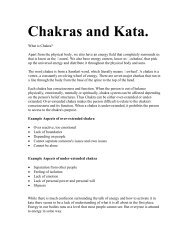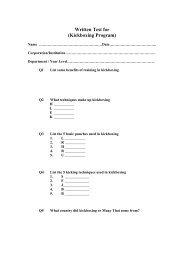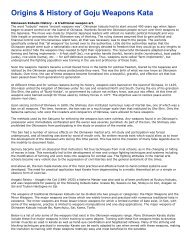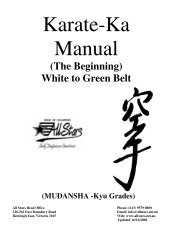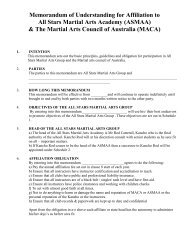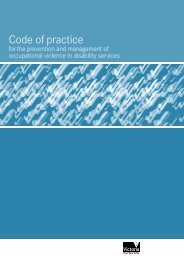The Journey - All Stars Self Defence Centres
The Journey - All Stars Self Defence Centres
The Journey - All Stars Self Defence Centres
You also want an ePaper? Increase the reach of your titles
YUMPU automatically turns print PDFs into web optimized ePapers that Google loves.
<strong>The</strong> <strong>Journey</strong><br />
It is important to note that at many stages of life we encounter barriers or resistance, walls we create and walls<br />
others create. <strong>The</strong> walls we create we have control over, we can either overcome and break through these<br />
obstacles and fears that we have produced or let them control our lives forever. <strong>The</strong> choice is within your reach,<br />
you have the ability to take back control and conquer these fears. Become mentally stronger from the<br />
experience and grow.<br />
<strong>The</strong> barriers are there from the start, as you walk in the dojo to begin training in the way of martial arts, or<br />
attempting your next rank. <strong>The</strong>y are all there to test our resolve, determination and our resilience to obstacles<br />
life throws us along the way.<br />
Our mind is the weakest when we talk about the battles of the mind, body and spirit. Certain gradings and kata<br />
address these issues. You must study hard to understand this, practise, read books, attend class more regularly,<br />
do whatever is required to improve yourself, with the aim in developing a stronger mind set.<br />
Below is one such examples of some walls we encounter in martial arts, you can make your own analogy with<br />
an examples to compare against. Second Dan (Contributions By John Moumas)<br />
This grading is one of the hardest physical efforts you could endure. You have gone beyond normal physical<br />
limitations and entered the mental realms of Bushido – code of the warrior extending your fighting spirit far<br />
beyond that of any normal expectations. Proving yourself in battle to be a true warrior following the martial<br />
way.<br />
<strong>The</strong>re are a few things that a student attempting second dan needs to be aware of, firstly there are a few barriers<br />
of resistance or obstacles that you will need to overcome, mentally and physically. <strong>The</strong> fight at second dan is to<br />
overcome the mind, the stress it will create.<br />
<strong>The</strong> mental obstacle is first encountered at that point you mentally and openly announce to everyone that you<br />
are attempting second dan.<br />
<strong>The</strong>n it happens at that point during training, which is a realization and an awakening of the amount of training,<br />
hard work and sacrifice required.<br />
Thirdly at that point before the grading where you hopefully committ to it without any fear or apprehension of<br />
the consequences. You acknowledge and accept that anything can and will happen during your grading and you<br />
are required to just take it in and use this to motivate and drive you towards the finish.<br />
<strong>The</strong> physical challenge is that of pushing your body past its normal physical limits and embracing the pain and<br />
fatigue that you are experiencing along the way. This is a lonely journey that only few can proudly say they<br />
have experienced. Remember it is the journey you travel not the destination that is the lesson to be learnt. <strong>The</strong><br />
technical side of the training for second dan is to build your skills to a level you thought unattainable and<br />
impossible.<br />
Upon passing your second dan, you are now able to put red writing on your belt, which signifys the efforts that<br />
have been made to achieve this grade. <strong>The</strong> red is symbolic of blood, a representation of the journey travelled<br />
with much sacrifice, hardwork and pain to reach this mile stone of achievement and personal development.<br />
<strong>The</strong> self realisation is quite unique and very personal for everyone. This grade should drive and inspire you to<br />
bigger and greater things, with the determination that nothing is impossible, nothing is too hard, with the<br />
support of your fellow bushido brothers and sisters you can do much good for all who are around you and your
club. <strong>The</strong> writing written traditionally in Japanese has your surname on the left hand side and your style on the<br />
other. (Fighting in ideal conditions)<br />
Nidan<br />
“<strong>The</strong> Blood Grading”<br />
<strong>The</strong> Nidan grading is quite often the most difficult of grading to understand. As a martial artist you go through<br />
various phases of your training to get to a certain level. Often once you have trained for a specified time or have<br />
acquired certain skills and a level of understanding you are required to perform these skills in front of your<br />
peers to be acknowledged and promoted to the next level.<br />
With Nidan the process is somewhat the same however very different. <strong>All</strong> other gradings before Nidan<br />
concentrate mostly on the physical skill level of the student and his/her understanding of those skills and their<br />
application. Gradings above and including Black belt, the student is expected to understand technique<br />
applications and its multiple variations. With the first Dan grade, this is then further extended to include the<br />
basic application of a chosen wooden weapon.<br />
<strong>The</strong> Nidan Grading which follows however, is very different than all previous levels. This level primarily<br />
focuses on the mental and spiritual aspects of the student. At first glance, it clearly appears to be the most<br />
physical of all grading requirements, which is true, however this is the very aspect which allows us to tap into<br />
the real meaning behind this grading. As it is only through extreme physical exsertion that we are able to enter<br />
the true realm of the mind and spirit. When there is no physical skills left, no techniques to execute, no energy<br />
left to exert, does the true power of the mind and spirit take over.<br />
This is the true measure of a human being. <strong>The</strong> mental and spiritual ability that drives the physical body. To<br />
explain this, I must go back to basics so one can truly try to understand this level. People as a basic measure of<br />
function, rely on motor skills to accomplish daily tasks. Given that these motor skills are controlled by our<br />
mind, this is the basic function of our existence, with the spirit controlling our emotions. In Martial Arts we<br />
often talk about these three basics, that as students, we try to isolate and improve.<br />
”Body, Mind, Spirit”<br />
<strong>The</strong> Nidan Grading is about the student being graded on the Mind and Spirit, but in doing so we must test the<br />
first level, that is the Body. It is only when the body’s diminished ability to defend itself through physical<br />
exertion (depleted motor skills) can we see the other two levels. You cannot skip one level to get to the other.<br />
One must be depleted in order to get to the next. Hence the reason for the grading requirements centred on a lot<br />
of physical activity. I have heard some students say that such a level of exertion is extreme, however the<br />
requirements are of such a level is to achieve motor skill depletion, in order to see the inner being of the<br />
students mind and spirit. I have also been asked by some students as to the validity of such extremes and their<br />
purpose. I will try to explain this.<br />
<strong>The</strong> Nidan Grading is often referred to as the blood grading. In human terms and throughout human society the<br />
spilling of blood (human or animal) signifies sacrifice and suffering. It is often the most selfless of human acts,<br />
to give of oneself without forethought or malice. To give oneself also requires a level of suffering (to go without<br />
that which you have had) and through these acts comes a strange new learning. We learn something about<br />
ourselves. To give yourself and to suffer, strengthens your level of both mind and spirit.<br />
Throughout your Nidan training you start to embark on a large journey of physical sacrifice and suffering. <strong>The</strong><br />
sacrifice takes many forms. Physical sacifrice through your training, (ie constant hard sparring, running,<br />
extreme physical excertion etc), time taken away from family whilst training, loss of social activity and the list<br />
goes on. To wholeheartedly lose yourself in your Nidan training is to sacrifice yourself, to endure the lost time
away from family and friends is to endure suffering. This is one of the meanings of the Nidan Grading. <strong>The</strong><br />
additional training you embark outside the dojo is a large component of your training. Without this additional<br />
training you would not be able to attain the physical condition required to achieve this grade. However, this too<br />
achieves another goal. <strong>The</strong> drive of your human spirit is brought into play. <strong>The</strong> will to push yourself to train that<br />
little bit extra. <strong>The</strong> will to run that extra kilometre. <strong>The</strong> will to fight another round. <strong>The</strong>se acts intensify and<br />
strengthen the mind and spirit throughout your training.<br />
At this point, I would like you to acknowledge that without this journey of sacrifice and suffering your journey<br />
to being a true Nidan cannot be achieved. It is through this very long and arduous time that the strength of mind<br />
and spirit comes through. <strong>The</strong> end result or performance on grading day in front of your peers is only a small<br />
percentage of the total achievement.<br />
For some, the step from Shodan (full Black Belt) to Nidan can seem to be a huge step and an insurmountable<br />
task. <strong>The</strong> moment a student decides to embark on this journey, he/she makes a mental commitment or decision<br />
to suffer and sacrifice all that is required to achieve the goal. To give all that is required of themselves without<br />
forethought or malice. That is the key right there. <strong>The</strong> mental hurdle. That first step. Also the training process<br />
becomes a learning experience in itself. Often you encounter injuries, physical plateaus, which you must learn<br />
to overcome and conquer. In order to do this, you resort to self analytical means. That’s to say, you start to<br />
question yourself and others around you. This process is also a key part of the training and learning process.<br />
<strong>The</strong> ability to dig deep within yourself, to overcome through grit and determination, to draw on your reserves of<br />
spiritual strength to pull yourself through.<br />
In this aspect, we can draw on the experiences of any professional endurance athlete; say a marathon runner, or<br />
distance swimmer. <strong>The</strong>ir experiences and encounters through their training process are similar to what a student<br />
attempting Nidan would experience. Ask yourself some key questions here. What is the common dominator<br />
here What similarities can both a Martial Artist (whilst training for Nidan) and an endurance athlete have<br />
Although the physical training programmes might differ, the mental and spiritual strengths which are<br />
heightened and strengthened on such a journey are the same.<br />
<strong>The</strong> Martial Artists takes this experience called the blood grading and stores it in his/her arsenal of techniques.<br />
Strength of mind and spirit, and its use, in both verbal and physical confrontational situations can be very<br />
powerful. In fact, your experiences with Nidan will teach you a lot about yourself and the depths of your inner<br />
being. <strong>The</strong>se self realisation experiences will help you to cope with everyday situations within your life. Just<br />
like a marathon runner, who is not phased at running 10 kilometres, a Martial Artist at this level is not phased<br />
by enduring moments of spiritual and/or mental hardships, be it at work or home. At this point, you realise that<br />
your strength of spirit and mind will help you to overcome any obstacles that confront you in life. This is one of<br />
the true lessons to be learnt from your Nidan grading.<br />
To this end, try to imagine the results for a student, if the Nidan grading requirement were say a personal kata<br />
and the Sunseroo ‘Eye of the Tornado’ kata only. I would safely say that the grading panel would not be able to<br />
see the true inner strengths of the student, nor would the student have learnt strength of spirit or mind.<br />
Now lets look at the grading itself. Back many years ago, the grading requirements for Nidan were kata to be<br />
performed ranging from Brown Belt through to Nidan plus a personal Kata. <strong>The</strong> sparring requirements were 30<br />
X 2 minute rounds with a fresh opponent each round. This to be taken from a fight pool of 5 (as a minimum).<br />
As you could imagine, the sparring was quite often hard and fast, especially in the later rounds when the student<br />
attempting rank was slower in technique application and obviously fairly tired. Today the requirements differ,<br />
however the end result is still the same. <strong>The</strong> kata requirements are unchanged, with all pad & sparring rounds<br />
now of 3 minutes duration. <strong>The</strong> first half of the grading concentrating on skill and technique of hands & legs on<br />
forearm pads and shields (9 rounds in total), then followed by 3 rounds of shadow sparring. During this phase,<br />
the student is being worked hard with a minimum of 80% physical output. <strong>The</strong> last phase of the grading is 8 X 3<br />
minute rounds of touch contact sparring. This is the key phase of the grading where the student is tested to the
extreme. By this I mean, the body is tired and is being broken down. This is to say, hand and leg techniques<br />
become slower and less sharp leaving the remaining two resources (mind & spirit) to be drawn on. How much<br />
the student draws on and shows the grading panel will depend on his/hers Nidan training programme and the<br />
experiences drawn up to that point, the ability not to give up at any cost, to keep on going, to sacrifice oneself<br />
whole heartedly without malice and forethought. In the process of the Nidan training, there is a natural<br />
progression and improvement of fight skills and their application. This is a natural process which occurs as part<br />
of the training itself. However the student considering entering the journey called the blood grading, should<br />
realise that this will be a natural improvement but not necessarily the key on which to focus their training on.<br />
Consider that with the growth and strength of mind and spirit along the way, the physical training does not<br />
become a major hurdle. However, without this strength, the physical hurdle becomes an insurmountable<br />
mountain and many barriers start to present themselves, often resulting in the abandonment of the training<br />
altogether.<br />
For many who are about to begin the journey or for those who the journey awaits in the distant future, each<br />
student travels a different road to Nidan and each student’s experience is different and unique, however the<br />
result is the same. This is also a good resource to draw on for those embarking on the journey. Ask those who<br />
have travelled before you. <strong>The</strong>y may become a light along the way.<br />
Yours in Martial Arts<br />
Sensei John Moumas
Development and Application of ;<br />
Toning and Fitness<br />
This is achieved through watching what we eat and high activity in a class, a balance of aerobic (occurring over<br />
long periods of activity - uses oxygen to produce the energy required) and anaerobic activity (ability to produce<br />
multiple repetitions of movement without fatigue - Short duration, usually under 90 seconds, does require<br />
oxygen to produce energy, depends on the bodies own system for energy to the muscles.) One is fat burning and<br />
the other is weight reducing so train carefully. Aerobic activity is anything over 2minutes and anaerobic activity<br />
is anything under 2minutes duration. Aerobic activity is the best for weight reduction, or anaerobic activity is<br />
best for fat burning or toning.<br />
Strength<br />
During training we developed strength by various exercises such as push ups, sit ups, squats, dips, leg work,<br />
upper body work. Training for strength also improves speed, but endurance not at all. Repetitions of 5-10 would<br />
be a good starting point then building it up to your desired target you want to achieve. But start slow and<br />
gradually increase your repetitions. Movements must also be performed slowly to maximise your effort in<br />
muscle development of slow twitch fibres. A strong muscle is a more flexible muscle so incorporating<br />
stretching into your routine is a great benefit.<br />
Power<br />
(1) law of motion - every action has an equal and opposite reaction (Newton's 3rd law)<br />
(2) ultimate power travels forward in a straight line (Newton's 1st law)<br />
(3) for non-collision style outcomes: F = ma (force equal mass times acceleration) (Newton's 2nd law)<br />
(4) for collision style outcomes: kinetic energy = mv2/2<br />
(4) ultimate power is generated from the hips<br />
(5) power is the amount of work done over time; work = force x displacement<br />
(6) power can be generated in three main ways<br />
(a) torquing of the hips<br />
(b) forward momentum - stepping and sliding<br />
(c) weight transfer from one leg to another<br />
(7) the breath should be synchronised with muscular activity<br />
Speed<br />
This is achieved by good technique and then speed. Working slow twitch and fast twitch muscle fibres, so over<br />
time, with stretching and strengthening our body and muscles we can then work and develop speed through a<br />
vast variety of exercises in class. Training for speed gives good all round results, (sprinters score moderately<br />
well on strength and endurance tests).<br />
Endurance<br />
Most students want to get fit for various reasons, generally it is for overall well being. Fitness is broken into<br />
different types, ie aerobic or anaerobic activity, one is short distance and the other is long distance or more<br />
endurance or stamina work. Training for endurance provides very little improvement of strength or speed. This<br />
means training for periods of 20 minutes<br />
3-4 times per week will help build endurance fitness. <strong>All</strong> aerobic activities have one thing in common; by<br />
making you work hard, they depend on plenty of oxygen. That’s what makes them aerobic.
Conditioning<br />
Conditioning exercise include thigh conditioning, body conditioning, forearm conditioning. This could also<br />
include conditioning of lower body through various exercises, upper body as well. <strong>The</strong>se exercises are designed<br />
to develop resistance to pain and injury through toughening or conditioning the muscles to the impacting<br />
sustained during competition, and for endurance of a long grading requiring certain fitness to carry you through<br />
the grade.<br />
To succeed with your new healthy diet and training routine, make gradual changes to your current routine.<br />
Make changes which suit your way of life and above all, enjoy it!<br />
In relation to any exercise or diet please consult your family doctor or your local dietician for advice, as some<br />
people may have special dietary needs or health issues that may have to be considered, for your overall well<br />
being and in achieving your goals.<br />
Stretching and Flexibility<br />
Physiology of Stretching<br />
<strong>The</strong> purpose of this chapter is to introduce you to some of the basic physiological concepts that come into play<br />
when a muscle is stretched. Concepts will be introduced initially with a general overview and then (for those<br />
who want to know the gory details) will be discussed in further detail. If you aren't all that interested in this<br />
aspect of stretching, you can skip this chapter. Other sections will refer to important concepts from this chapter<br />
and you can easily look them up on a "need to know" basis.<br />
• <strong>The</strong> musculoskeletal system<br />
• Muscle composition<br />
• Connective Tissue<br />
• Co-operating muscle groups<br />
• Types of muscle contractions<br />
• What happens when you stretch<br />
<strong>The</strong> musculoskeletal system<br />
Together, muscles and bones comprise what is called the musculoskeletal system of the<br />
body. <strong>The</strong> bones provide posture and structural support for the body and the muscles<br />
provide the body with the ability to move (by contracting, and thus generating tension).<br />
<strong>The</strong> musculoskeletal system also provides protection for the body's internal organs. In<br />
order to serve their function, bones must be joined together by something. <strong>The</strong> point where bones connect to<br />
one another is called a joint, and this connection is made mostly by ligaments (along with the help of muscles).<br />
Muscles are attached to the bone by tendons. Bones, tendons, and ligaments do not possess the ability (as<br />
muscles do) to make your body move. Muscles are very unique in this respect.<br />
Muscle composition<br />
Muscles vary in shape and in size, and serve many different purposes. Most large<br />
muscles, like the hamstrings and quadriceps, control motion. Other muscles, like the heart, and the muscles of<br />
the inner ear, perform other functions. At the microscopic level<br />
however, all muscles share the same basic structure. At the highest level, the (whole) muscle is composed of<br />
many strands of tissue called fascicles. <strong>The</strong>se are the strands of muscle that we see when we cut red meat or<br />
poultry. Each fascicle is composed of fasciculi which are bundles of muscle fibres. <strong>The</strong> muscle fibres are in turn<br />
composed of tens of thousands of thread-like myofybrils, which can contract, relax, and elongate (lengthen).<br />
<strong>The</strong> myofybrils are (in turn) composed of up to millions of bands laid end-to-end called sarcomeres. Each<br />
sarcomere is made of overlapping thick and thin filaments called myofilaments. <strong>The</strong> thick and thin<br />
myofilaments are made up of contractile proteins, primarily actin and myosin.
How Muscles Contract<br />
<strong>The</strong> way in which all these various levels of the muscle operate is as follows: Nerves<br />
connect the spinal column to the muscle. <strong>The</strong> place where the nerve and muscle meet is<br />
called the neuromuscular junction. When an electrical signal crosses the neuromuscular<br />
junction, it is transmitted deep inside the muscle fibres. Inside the muscle fibres, the signal stimulates the flow<br />
of calcium which causes the thick and thin myofilaments to slide across one another. When this occurs, it causes<br />
the sarcomere to shorten, which generates force. When billions of sarcomeres in the muscle shorten all at once it<br />
results in a contraction of the entire muscle fibre. When a muscle fibre contracts, it contracts completely. <strong>The</strong>re<br />
is no such thing as a partially contracted muscle fibre. Muscle fibres are unable to vary the intensity of their<br />
contraction relative to the load against which they are acting. If this is so, then how does the force of a muscle<br />
contraction vary in strength from strong to weak What happens is that more muscle fibres are recruited, as they<br />
are needed, to perform the job at hand. <strong>The</strong> more muscle fibres that are recruited by the central nervous system,<br />
the stronger the force generated by the muscular contraction.<br />
Fast and Slow Muscle Fibres<br />
<strong>The</strong> energy which produces the calcium flow in the muscle fibres comes from<br />
mitochondria, the part of the muscle cell that converts glucose (blood sugar) into energy.<br />
Different types of muscle fibres have different amounts of mitochondria. <strong>The</strong> more<br />
mitochondria in a muscle fibre, the more energy it is able to produce. Muscle fibres are categorised into slowtwitch<br />
fibres and fast-twitch fibres. Slow-twitch fibres (also called Type 1 muscle fibres) are slow to contract,<br />
but they are also very slow to fatigue. Fast-twitch fibres are very quick to contract and come in two varieties:<br />
Type 2A muscle fibres which fatigue at an intermediate rate, and Type 2B muscle fibres which fatigue very<br />
quickly. <strong>The</strong> main reason the slow-twitch fibres are slow to fatigue is that they contain more mitochondria than<br />
fast-twitch fibres and hence are able to produce more energy. Slowtwitch fibres are also smaller in diameter<br />
than fast-twitch fibres and have increased<br />
capillary blood flow around them. Because they have a smaller diameter and an increased<br />
blood flow, the slow-twitch fibres are able to deliver more oxygen and remove more waste products from the<br />
muscle fibres (which decreases their "fatigability").<br />
<strong>The</strong>se three muscle fibre types (Types 1, 2A, and 2B) are contained in all muscles in<br />
varying amounts. Muscles that need to be contracted much of the time (like the heart)<br />
have a greater number of Type 1 (slow) fibres. When a muscle first starts to contract, it is<br />
primarily Type 1 fibres that are initially activated, then Type 2A and Type 2B fibres are<br />
activated (if needed) in that order. <strong>The</strong> fact that muscle fibres are recruited in this sequence is what provides the<br />
ability to execute brain commands with such fine-tuned tuned muscle responses. It also makes the Type 2B<br />
fibres difficult to train because they are not activated until most of the Type 1 and Type 2A fibres have been<br />
recruited. Perhaps the best way to remember the difference between muscles with predominantly slow-twitch<br />
fibres and muscles with predominantly fast-twitch fibres is to think of "white meat" and "dark meat". Dark meat<br />
is dark because it has a greater number of slow-twitch muscle fibres and hence a greater number of<br />
mitochondria, which are dark. White meat consists mostly of muscle fibres which are at rest much of the time<br />
but are frequently called on to engage in brief bouts of intense activity. This muscle tissue can contract quickly<br />
but is fast to fatigue and slow to recover. White meat is lighter in colour than dark meat because it contains<br />
fewer mitochondria.
Connective Tissue<br />
Located all around the muscle and its fibres are connective tissues. Connective tissue is<br />
composed of a base substance and two kinds of protein based fibre. <strong>The</strong> two types of fibre are collagenous<br />
connective tissue and elastic connective tissue. Collagenous connective tissue consists mostly of collagen<br />
(hence its name) and provides tensile strength. Elastic connective tissue consists mostly of elastin and (as you<br />
might guess from its name) provides elasticity. <strong>The</strong> base substance is called mucopolysaccharide and acts as<br />
both a lubricant (allowing the fibres to easily slide over one another), and as a glue (holding the fibres of the<br />
tissue together into bundles). <strong>The</strong> more elastic connective tissue there is around a joint, the greater the range of<br />
motion in that joint. Connective tissues are made up of tendons, ligaments, and the fascial sheaths that envelop,<br />
or bind down, muscles into separate groups. <strong>The</strong>se fascial sheaths, or fascia, are named according to where they<br />
are located in the muscles:<br />
Endomysium<br />
<strong>The</strong> innermost fascial sheath that envelops individual muscle fibres.<br />
Perimysium<br />
<strong>The</strong> fascial sheath that binds groups of muscle fibres into individual fasciculi (see section 'muscle composition'.<br />
Epimysium<br />
<strong>The</strong> outermost fascial sheath that binds entire fascicles (see section 'muscle<br />
composition'). <strong>The</strong>se connective tissues help provide suppleness and tone to the muscles.<br />
Co-operating Muscle Groups<br />
When muscles cause a limb to move through the joint's range of motion, they usually act in the following<br />
cooperating groups:<br />
Agonists<br />
<strong>The</strong>se muscles cause the movement to occur. <strong>The</strong>y create the normal range of<br />
movement in a joint by contracting. Agonists are also referred to as prime movers since<br />
they are the muscles that are primarily responsible for generating the movement.<br />
Antagonists<br />
<strong>The</strong>se muscles act in opposition to the movement generated by the agonists and are<br />
responsible for returning a limb to its initial position.<br />
Synergists<br />
<strong>The</strong>se muscles perform, or assist in performing, the same set of joint motion as the<br />
agonists. Synergists are sometimes referred to as neutralizers because they help<br />
cancel out, or neutralize, extra motion from the agonists to make sure that the force<br />
generated works within the desired plane of motion.<br />
Fixators<br />
<strong>The</strong>se muscles provide the necessary support to assist in holding the rest of the body<br />
in place while the movement occurs. Fixators are also sometimes called stabilizers.<br />
As an example, when you flex your knee, your hamstring contracts, and, to some extent,<br />
so does your gastrocnemius (calf) and lower buttocks. Meanwhile, your quadriceps are<br />
inhibited (relaxed and lengthened somewhat) so as not to resist the flexion (see section<br />
'reciprocal inhibition'). In this example, the hamstring serves as the agonist, or prime<br />
mover; the quadricep serves as the antagonist; and the calf and lower buttocks serve as<br />
the synergists. Agonists and antagonists are usually located on opposite sides of the<br />
affected joint (like your hamstrings and quadriceps, or your triceps and biceps), while<br />
synergists are usually located on the same side of the joint near the agonists. Larger<br />
muscles often call upon their smaller neighbours to function as synergists.<br />
<strong>The</strong> following is a list of commonly used agonist / antagonist muscle pairs:<br />
• pectorals/latissimus dorsi (pecs and lats)<br />
• anterior deltoids/posterior deltoids (front and back shoulder)
• trapezius/deltoids (traps and delts)<br />
• abdominals/spinal erectors (abs and lower-back)<br />
• left and right external obliques (sides)<br />
• quadriceps/hamstrings (quads and hams)<br />
• shins/calves<br />
• biceps/triceps<br />
• forearm flexors/extensors<br />
Types of Muscle Contractions<br />
<strong>The</strong> contraction of a muscle does not necessarily imply that the muscle shortens; it only<br />
means that tension has been generated. Muscles can contract in the following ways:<br />
Isometric contraction<br />
This is a contraction in which no movement takes place, because the load on the<br />
muscle exceeds the tension generated by the contracting muscle. This occurs when a<br />
muscle attempts to push or pull an immovable object.<br />
Isotonic contraction<br />
This is a contraction in which movement does take place, because the tension<br />
generated by the contracting muscle exceeds the load on the muscle. This occurs<br />
when you use your muscles to successfully push or pull an object.<br />
Note: Isotonic contractions are further divided into two types as follows:<br />
Concentric contraction<br />
This is a contraction in which the muscle decreases in length (shortens) against an<br />
opposing load, such as lifting a weight up.<br />
Eccentric contraction<br />
This is a contraction in which the muscle increases in length (lengthens) as it resists a<br />
load, such as lowering a weight down in a slow, controlled fashion.<br />
During a concentric contraction, the muscles that are shortening serve as the agonists and hence do all of the<br />
work. During an eccentric contraction the muscles that are lengthening serve as the agonists (and do all of the<br />
work). See section co-operating muscle groups.<br />
What Happens When you Stretch<br />
<strong>The</strong> stretching of a muscle fibre begins with the sarcomere (see section 'muscle<br />
composition'), the basic unit of contraction in the muscle fibre. As the sarcomere contracts, the area of overlap<br />
between the thick and thin myofilaments increases. As it stretches, this area of overlap decreases, allowing the<br />
muscle fibre to elongate. Once the muscle fibre is at its maximum resting length (all the sarcomeres are fully<br />
stretched), additional stretching places force on the surrounding connective tissue (see section 'connective<br />
tissue'). As the tension increases, the collagen fibres in the connective tissue align themselves along the same<br />
line of force as the tension. Hence when you stretch, the muscle fibre is pulled out to its full length sarcomere<br />
by sarcomere, and then the connective tissue takes up the remaining slack. When this occurs, it helps to realign<br />
any disorganized fibres in the direction of the tension. This realignment is what helps to rehabilitate scarred<br />
tissue back to health.<br />
When a muscle is stretched, some of its fibres lengthen, but other fibres may remain at<br />
rest. <strong>The</strong> current length of the entire muscle depends upon the number of stretched fibres<br />
(similar to the way that the total strength of a contracting muscle depends on the number<br />
of recruited fibres contracting). According to SynerStretch you should think of "little pockets of fibres<br />
distributed throughout the muscle body stretching, and other fibres simply going along for the ride". <strong>The</strong> more<br />
fibres that are stretched, the greater the length developed by the stretched muscle.<br />
• Proprioceptors<br />
• <strong>The</strong> Stretch Reflex<br />
• <strong>The</strong> Lengthening Reaction<br />
• Reciprocal Inhibition
Proprioceptors<br />
<strong>The</strong> nerve endings that relay all the information about the musculoskeletal system to the<br />
central nervous system are called proprioceptors. Proprioceptors (also called<br />
mechanoreceptors) are the source of all proprioception: the perception of one's own body<br />
position and movement. <strong>The</strong> proprioceptors detect any changes in physical displacement<br />
(movement or position) and any changes in tension, or force, within the body. <strong>The</strong>y are<br />
found in all nerve endings of the joints, muscles, and tendons. <strong>The</strong> proprioceptors related<br />
to stretching are located in the tendons and in the muscle fibres. <strong>The</strong>re are two kinds of muscle fibres: intrafusal<br />
muscle fibres and extrafusal muscle fibres. Extrafusil fibres are the ones that contain myofibrils (see section<br />
'muscle composition') and are what is usually meant when we talk about muscle fibres. Intrafusal fibres are also<br />
called muscle spindles and lie parallel to the extrafusal fibres. Muscle spindles, or stretch receptors, are the<br />
primary proprioceptors in the muscle. Another proprioceptor that comes into play during stretching is located in<br />
the tendon near the end of the muscle fibre and is called the golgi tendon organ. A third type of proprioceptor,<br />
called a pacinian corpuscle, is located close to the golgi tendon organ and is responsible for detecting changes in<br />
movement and pressure within the body. When the extrafusal fibres of a muscle lengthen, so do the intrafusal<br />
fibres (muscle spindles). <strong>The</strong> muscle spindle contains two different types of fibres (or stretch receptors) which<br />
are sensitive to the change in muscle length and the rate of change in muscle length. When muscles contract it<br />
places tension on the tendons where the golgi tendon organ is located. <strong>The</strong> golgi tendon organ is sensitive to the<br />
change in tension and the rate of change of the tension.<br />
<strong>The</strong> Stretch Reflex<br />
When the muscle is stretched, so is the muscle spindle (see section 'proprioceptors'). <strong>The</strong><br />
muscle spindle records the change in length (and how fast) and sends signals to the spine<br />
which convey this information. This triggers the stretch reflex (also called the myotatic<br />
reflex) which attempts to resist the change in muscle length by causing the stretched<br />
muscle to contract. <strong>The</strong> more sudden the change in muscle length, the stronger the<br />
muscle contractions will be (plyometric, or "jump", training is based on this fact). This basic function of the<br />
muscle spindle helps to maintain muscle tone and to protect the body from injury. One of the reasons for<br />
holding a stretch for a prolonged period of time is that as you hold the muscle in a stretched position, the muscle<br />
spindle habituates (becomes accustomed to the new length) and reduces its signalling. Gradually, you can train<br />
your stretch receptors to allow greater lengthening of the muscles. Some sources suggest that with extensive<br />
training, the stretch reflex of certain muscles can be controlled so that there is little or no reflex contraction in<br />
response to a sudden stretch. While this type of control provides the opportunity for the greatest gains in<br />
flexibility, it also provides the greatest risk of injury if used improperly. Only consummate professional athletes<br />
and dancers at the top of their sport (or art) are believed to actually possess this level of muscular control.<br />
Components of the Stretch Reflex<br />
<strong>The</strong> stretch reflex has both a dynamic component and a static component. <strong>The</strong> static<br />
component of the stretch reflex persists as long as the muscle is being stretched. <strong>The</strong><br />
dynamic component of the stretch reflex (which can be very powerful) lasts for only a<br />
moment and is in response to the initial sudden increase in muscle length.<br />
<strong>The</strong> reason that the stretch reflex has two components is because there are actually two<br />
kinds of intrafusal muscle fibres: nuclear chain fibres, which are responsible for the static<br />
component; and nuclear bag fibres, which are responsible for the dynamic component.<br />
Nuclear chain fibres are long and thin, and lengthen steadily when stretched. When these<br />
fibres are stretched, the stretch reflex nerves increase their firing rates (signalling) as their<br />
length steadily increases. This is the static component of the stretch reflex. Nuclear bag fibres bulge out at the<br />
middle, where they are the most elastic. <strong>The</strong> stretch sensing nerve ending for these fibres is wrapped around this<br />
middle area, which lengthens rapidly when the fibre is stretched. <strong>The</strong> outer-middle areas, in contrast, act like<br />
they are filled with viscous fluid; they resist fast stretching, then gradually extend under prolonged tension. So,<br />
when a fast stretch is demanded of these fibres, the middle takes most of the stretch at first; then, as the outermiddle<br />
parts extend, the middle can shorten somewhat. So the nerve that senses stretching in these fibres fires
apidly with the onset of a fast stretch, then slows as the middle section of the fibre is allowed to shorten again.<br />
This is the dynamic component of the stretch reflex: a strong signal to contract at the onset of a rapid increase in<br />
muscle length, followed by slightly "higher than normal" signalling which gradually decreases as the rate of<br />
change of the muscle length decreases.<br />
<strong>The</strong> Lengthening Reaction<br />
When muscles contract (possibly due to the stretch reflex), they produce tension at the<br />
point where the muscle is connected to the tendon, where the golgi tendon organ is<br />
located. <strong>The</strong> golgi tendon organ records the change in tension, and the rate of change of<br />
the tension, and sends signals to the spine to convey this information (see section<br />
'proprioceptors'). When this tension exceeds a certain threshold, it triggers the lengthening reaction which<br />
inhibits the muscles from contracting and causes them to relax. Other names for this reflex are the inverse<br />
myotatic reflex, autogenic inhibition, and the clasped-knife reflex. This basic function of the golgi tendon organ<br />
helps to protect the muscles, tendons, and ligaments from injury. <strong>The</strong> lengthening reaction is possible only<br />
because the signalling of golgi tendon organ to the spinal cord is powerful enough to overcome the signalling of<br />
the muscle spindles telling the muscle to contract. Another reason for holding a stretch for a prolonged period of<br />
time is to allow this lengthening reaction to occur, thus helping the stretched muscles to relax. It is easier to<br />
stretch, or lengthen, a muscle when it is not trying to contract.<br />
Reciprocal Inhibition<br />
When an agonist contracts, in order to cause the desired motion, it usually forces the<br />
antagonists to relax (see section 'co-operating muscle groups'). This phenomenon is called reciprocal inhibition<br />
because the antagonists are inhibited from contracting. This is<br />
sometimes called reciprocal innervation but that term is really a misnomer since it is the<br />
agonists which inhibit (relax) the antagonists. <strong>The</strong> antagonists do not actually innervate<br />
(cause the contraction of) the agonists. Such inhibition of the antagonistic muscles is not necessarily required. In<br />
fact, co-contraction can occur. When you perform a sit-up, one would normally assume that the stomach<br />
muscles inhibit the contraction of the muscles in the lumbar, or lower, region of the back. In this particular<br />
instance however, the back muscles (spinal erectors) also contract. This is one reason why sit-ups are good for<br />
strengthening the back as well as the stomach. When stretching, it is easier to stretch a muscle that is relaxed<br />
than to stretch a muscle that is contracting. By taking advantage of the situations when reciprocal inhibition<br />
does occur, you can get a more effective stretch by inducing the antagonists to relax during the stretch due to<br />
the contraction of the agonists. You also want to relax any muscles used as synergists by the muscle you are<br />
trying to stretch. For example, when you stretch your calf, you want to contract the shin muscles (the<br />
antagonists of the calf) by flexing your foot. However, the hamstrings use the calf as a synergist so you want to<br />
also relax the hamstrings by contracting the quadricep (i.e., keeping your leg straight).
Running Program<br />
Running forms one of the major components to achieving your desire level of fitness and weight loss. It can<br />
also be achieved through regular walks and watching what you eat.<br />
Another good habit is to get into a routine of recording your running times and distances as well as what you eat<br />
each day of the week. This will be your best indicator of how you are doing and the best way your training can<br />
see what you are doing to assist you better in achieving your goals.<br />
An example of a standard running program that was given to me some years ago, which of course you can<br />
modify to suit yourself. Please note before each run you must first warm up on 1-2 km then stretch then begin<br />
your workout.<br />
Monday<br />
Tuesday<br />
Wednesday<br />
Thursday<br />
-Hill work 5-10 hill sprints or stair sprints. Find a local park with a hill or stairs and do this once<br />
a week.<br />
-Easy medium 5-6km run<br />
-Hard medium- 4 fast laps then jog a lap,<br />
-2 laps then jog a lap,<br />
-1 lap then jog a lap<br />
-Long easy run for 45 minutes to 1 hour<br />
Friday -Fast - sprint 100 metres jog a lap repeat 5-10 times<br />
Saturday -Recovery -run 2 laps hard then jog 1 lap easy repeat 5-10 times.<br />
Sunday<br />
-rest<br />
This running program is designed to increase your overall fitness and stamina eg. endurance without losing<br />
strength, while developing explosive speed and power in your legs. So as to be able to go the distance in your<br />
grading that requires much fitness and endurance.
Combination Sequences<br />
Level 1<br />
1 L/LEG THIGH CHECK<br />
2 REPEAT, ADD L/LEG FRONT KICK<br />
3 REPEAT ABOVE, ADD L/JAB<br />
4 REPEAT ABOVE,ADD L/R JAB<br />
5 REPEAT ABOVE,ADD L/HOOK<br />
6 REPEAT ABOVE,ADD R/LEG THIGH KICK<br />
Level 2<br />
1 SWITH INSIDE THIGH KICK<br />
2 REPEAT,ADD R/HAND<br />
3 REPEAT ABOVE,ADD L/BODY RIP<br />
4 REPEAT ABOVE,ADD L/HOOK<br />
5 REPEAT ABOVE,ADD R/HAND<br />
6 REPEAT ABOVE,ADD R/LEG THIGH KICK<br />
Level 3<br />
1 R/LEG FRONT KICK<br />
2 REPEAT,ADD L/LEG SPINNING SIDE KICK<br />
3 REPEAT ABOVE,ADD 2R/KNEES<br />
4 REPEAT ABOVE,ADD L/R/ ELBOW<br />
5 REPEAT ABOVE,ADD SWITCH 2 INSIDE THIGH KICKS<br />
6 REPEAT ABOVE,ADD R/HAND SPINNING BACK FIST<br />
Level 4<br />
I L/JAB AND SLIP OPPONENTS L/JAB<br />
2 REPEAT,ADD WEAVE R/LEG THIGH KICK,R/HAND<br />
3 REPEAT,ADD SLIP/WEAVE L/INSIDE THIGH KICK<br />
4 REPEAT,ADD WEAVE OPPONENTS R/HAND,L/RIP L/HOOK<br />
5 REPEAT,ADD R/L UPPERCUT R/OVERTOP<br />
6 REPEAT,ADD L/R/L JAB L/LEG ROUNHOUSE KICK
Nutrition<br />
That means eating at the right number of times per day, approximately 5-6 times per day as advised by<br />
dieticians to either lose weight or put weight on. This also means eating the right type and amount of foods and<br />
not eating too late at night. <strong>The</strong> aim is to speed up your metabolism not slow it down, it does that naturally as<br />
we get older. So activity and a good diet, is the key to maintaining good health and long life.<br />
<strong>The</strong> information below has been on nutrition has been provided by the good food chart or healthy diet pyramid<br />
from the Heart Foundation. <strong>The</strong> “eat least” foods are those high in fat, sugar, salt and alcohol. <strong>The</strong>se foods<br />
should only be consumed in small amounts as they provide lots of energy (kilojoules) but very few nutrients.<br />
Salt we need is found in the foods we eat so there is no need to add salt to food.<br />
<strong>The</strong> “eat moderate” foods are high in protein, vitamins and minerals need to be eaten each day to assist with<br />
body growth and repair. <strong>The</strong>se foods include meat, chicken, fish, eggs, dairy products (eg. milk, cheese and<br />
yoghurt), nuts and seeds. Choose the lower fat versions of these products like skim milk and lean meat, to avoid<br />
hidden kilojoules.<br />
<strong>The</strong> “eat most” are foods such as breads, cereals, fruit, vegetables, rice, pasta and legumes (dried peas, beans<br />
and lentils), should make up a major part of each of your meals. <strong>The</strong>se foods are low in fat, salt and sugar and<br />
high in fibre, complex carbohydrates, vitamins and minerals. <strong>The</strong>se are excellent source of energy and nutrients<br />
essential to health, they also satisfy hunger without adding to your waistline.<br />
<strong>The</strong>re are “fats and fats”, which include solid fats such as butter and fat on meat, as well as liquid fat known as<br />
oil.<br />
Saturated fats are mostly of animal origin. <strong>The</strong>y include butter, fat on meat, cheese, cream and milk fat. Some<br />
vegetable oils are used in the manufacture of biscuits, pastry and cakes.<br />
Polyunsaturated fats are usually liquid oils extracted from plant seeds. Polyunsaturated fat is also found in fish,<br />
ie tuna, salmon and sardines, lean meats.<br />
Monounsaturated fats are predominant in olives, olive oil, avocados, peanuts, peanut oil and also in eggs, lean<br />
meat and chicken, some fish and macadamia and hazel nuts.<br />
Both of these types of fats can help lower blood cholesterol levels when used instead of saturated fats.<br />
- for a normal blood cholesterol level(less than 5.5mmol/l) and good health,<br />
- polyunsaturated and monounsaturated fats when used sparingly can help lower blood cholesterol levels<br />
- eat cholesterol rich foods infrequently, especially if blood cholesterol is raised<br />
- remember all types of fats and oils have the same amount of energy (kilojoules) and are high kilojoule<br />
foods. <strong>All</strong> types of foods eaten in excess may contribute to overweight and obesity<br />
- eat a variety of foods each day<br />
- eat more fruits, vegetables, wholegrain cereals and legumes.<br />
Consider that heart disease is a major killer of Australians (46% die of heart disease each year) and that a<br />
healthy diet plays a major role in preventing heart disease.<br />
<strong>The</strong> main reason people join is the benefit of weight loss through high aerobic activity during class. This means<br />
through regular training of 3-4 times per week with a balanced diet, you should be able to achieve the realistic<br />
results you want. Working harder for long periods of time during class will assist in weight reduction. But it<br />
must be realistic and it must be balance with regular training, diet, and enough rest. Those who over-train by<br />
doing too much in a week or too many classes in one night run the risk of over-training and injuring themselves,<br />
so ask for advise from your trainer as too how much and how long should you train at any one time for.
Another factor is the alcohol or sugar we eat, if your body is burning kilojoules from alcohol and/, or<br />
carbohydrates, it won’t burn those from fat. This means that any fat you eat is likely to be added to your body<br />
fat and if you are trying to lose weight, consuming too much alcohol and sugar will make things much harder,<br />
maybe even impossible. If you eat more kilojoules than your body is burning, you can’t lose weight, only gain<br />
it. Don’t try to change everything at once, make small changes at a time.



